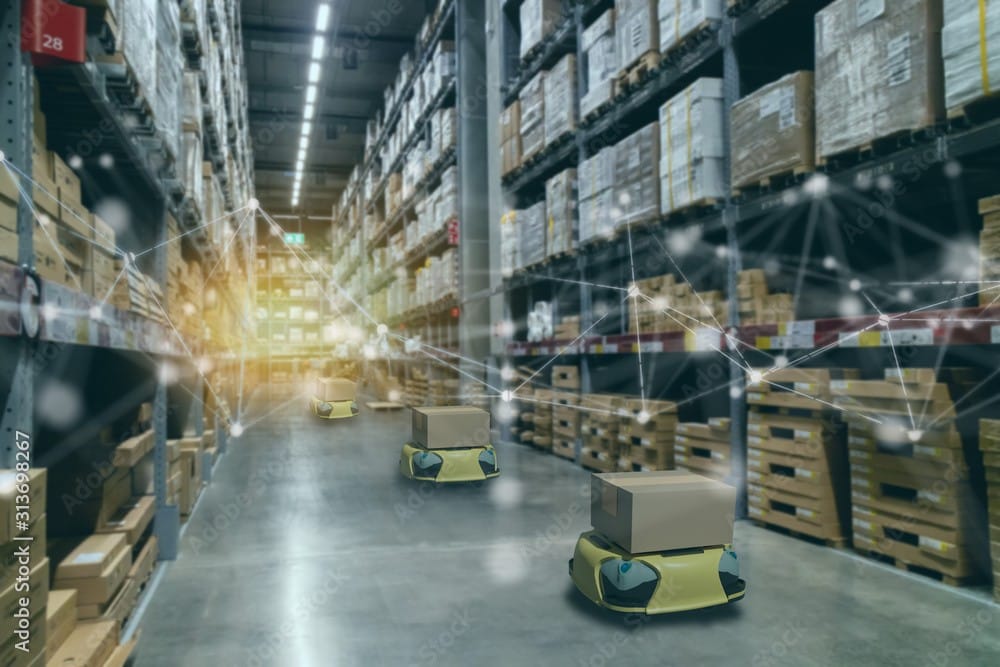Innovations in Warehouse Management
The pace of innovation in warehouse management can be dizzying. It seems like there are always new technologies and advancements to keep up with. In the past decade or so, innovative technologies have helped boost the productivity and efficiency of warehouse logistics. From improvements in automation and smart tech to software for effectively managing your supply chain, there are numerous ways these technological applications can improve operations. If you’re looking for ways to streamline your warehouse processes, you should consider partnering with a third-party logistics company prioritizing technology in its services to give you strong warehouse insights. Keep reading to check out the most promising warehouse management innovations that some of the top 3PL companies use and how they can benefit operations for logistics providers and their customers.
Warehouse Management Systems
Good organization is key to managing the ins and outs of daily warehouse operations. There are so many moving parts to track throughout the process that it can be challenging to visualize big-picture operations. Warehouse Management Systems (WMS) is software helping control and optimize warehouse operations. This tool is essentially the control center of the warehouse. It helps track inventory, manage orders, and simplify the entire process from when goods enter a warehouse to when they’re transported out. This software can improve overall efficiency and productivity, too. These systems use real-time data to provide performance analytics, so managers can identify pain points and optimize their workflows.
Some WMS have customer-facing applications, too. They can provide clients with up-to-date shipment information, inventory tracking, and billing information. At Prism, our customers have 24/7 access to crucial data on the client portal. They can enjoy real-time visibility of inventory, automated alerts about outbound shipments, and more. Read more about our cutting-edge technological advancements here.
Automation
Warehouse automation and robotics have been used for decades, but the technology is continuously evolving. Nowadays, automated procedures and tools play an essential role in logistics management. Many warehouses are using automation systems to increase productivity and efficiency, which in turn helps them to provide better service to their clients.
Warehouse automation and robotics can be used for a wide range of tasks, like:
- Picking items from shelves
- Palletizing
- Transporting pallets around the warehouse
Automation is beneficial to operations in many ways; it can help make warehouses operate more efficiently, reduce costs, and improve safety. Automation helps reduce labor costs by replacing manual processes with automated ones. For example, machines can be programmed to perform repetitive tasks such as scanning barcodes or picking items from shelves with little human intervention. This reduces labor costs as companies do not need to hire a large number of workers to perform these tasks anymore. Automation also lowers the risks associated with human error, allowing operations to run smoothly and efficiently. Robots can also perform tasks that are too dangerous for humans, such as lifting heavy objects, working on tall shelves, and handling hazardous materials. This kind of automation helps keep workers safe at all times while at work.
Smart Technology and the Internet of Things
Smart tech can revolutionize warehouse operations, allowing greater control and better optimization of procedures. The Internet of Things (IoT) is a network of physical objects or “things” embedded with software, sensors, and Internet connectivity enabling these objects to collect data and carry out commands autonomously.
Smart devices are used in warehouses to improve efficiency, accuracy, and safety. Some of the most popular smart warehouse devices include:
- Smart forklifts
- Radio-frequency identification (RFID) tags
- Motion sensors
- Pressure sensors
Interconnected sensors around the warehouse can monitor and control temperature, lighting, moisture levels, and more. This is essential for food and other temperature-sensitive products. If temperatures drop below or rise above set parameters, workers can be notified immediately and take action before damage occurs.
IoT sensors across the facility can simplify inventory management, too. The sensors can track assets as they move around the warehouse. Pressure sensors on smart shelves can monitor inventory levels and determine when products need to be replenished. This innovation will reduce workers’ time on inventory management, which could save companies money in the long run.
Tools like driverless forklifts can make facilities safer for workers and reduce workplace accidents. According to OSHA, forklifts are the most significant hazards in warehouses. In 2020, they caused 7,290 nonfatal injuries and 78 work-related deaths. Upgrading smart forklifts will reduce dangerous mistakes and make warehouses safer.
RFID Inventory Tracking
Real-time inventory tracking is essential for efficient warehouse operations so managers can avoid damage, spoilage, and theft. Radio Frequency Identification (RIFD) inventory tracking is a new technology coming to the forefront of warehouse operations management. The RFID tags are small devices capable of attaching to products and providing essential information. The tags can be detected and read remotely, allowing you to track all of your inventory in real-time.
There are many benefits of using RFID tags in your warehouse management system. Here are some of the top reasons why:
- Reduce Lost Product: When you have an accurate count of what is on hand, it’s easier to prevent theft and loss due to human error.
- Faster Order Fulfillment: RFID allows you to know exactly where each item is at any given time so you can fulfill orders quickly without wasting time looking for missing items or running out of stock unexpectedly due to mismanagement of inventory levels.
- Improved Inventory Accuracy: With traditional barcode scanning systems, there’s always the chance of human error during data entry due to misreading labels or bar code alignment issues. RFID tags automatically update the location and status of products within your inventory management software system.
All of these benefits translate to better real-time inventory tracking, more productive picking and packing, and happier clients.
Wearables
Wearables are becoming more and more popular in warehouses and the world at large. No, we’re not talking about fitness trackers and smart devices. There are devices specifically developed to improve efficiency and safety in these facilities. This type of innovative technology is designed to make workers’ jobs more straightforward and less strenuous, so they can be more productive without risking their health. Here are a few of the most popular warehouse-geared wearables and some of their benefits:
- Picking Gloves: Picking gloves are used for order fulfillment and picking goods from shelves. The gloves are an alternative to handheld scanners, so workers can have both hands free to pick orders safely.
- Scanning Glasses: These glasses have a camera embedded in them, allowing workers to scan barcodes from a distance and pick inventory more efficiently and accurately.
- Exoskeletons: Exoskeletons are wearable robots helping people easily lift heavy objects. This device reduces strain on workers’ backs, knees, wrists, and hands and eliminates workplace injuries caused by lifting heavy items improperly. It increases productivity as well.
These devices are still relatively new and are not widely used yet. However, they represent an exciting new direction for workplace safety and productivity measures.
Cloud-Based Tech
Cloud-based technology is a growing trend in most industries but can provide unique benefits for logistics providers. Cloud systems store data over the internet on remote servers rather than local ones, so the information is accessible anywhere at any time. This type of tech can integrate with IoT equipment in the facility, too. Data from these devices will be stored in the cloud, where it can then be analyzed to provide meaningful insights to warehouse employees and clients.
Cloud storage offers several advantages over traditional hardware:
- Security: Cloud servers are maintained by outside companies with high standards for cyber security, so you don’t have to worry about your data being compromised by hackers or viruses.
- Accessibility: Data can be accessed from anywhere with an internet connection, so workers around the facility can easily access the essential information they need to work productively. It’s helpful for clients, too. Authorized users can log into their account from any device with a web browser and seamlessly access information about their stored inventory and shipments.
- Scalability: Cloud servers are easy to scale, so they can keep up with changing data storage demands as your company grows.
When considering logistics operations, data storage may not be the first thing you think of. Nonetheless, it plays a vital role in providing exceptional customer service and optimizing warehouse procedures.
Drones
You’ve probably heard about drones as an exciting new way to deliver packages. But, they can also be used in warehouses to monitor inventory, conduct visual inspections, and detect problems. Drones have the potential to transform warehouse management entirely, making operations safer and more efficient. This automation can also help lower labor costs and reduce human error during everyday processing tasks.
Here are three ways that warehouse drones can improve operations and simplify processes:
- Inventory Management: Drones can help with audits, cycle counting, buffer stock maintenance, and item searches. They can be especially helpful in facilities with high storage shelves.
- Finding lost items: A drone can fly over an area and take photos or videos of products on shelves, which can help find missing items by comparing them against images taken earlier.
- Monitoring safety conditions: Drones can be used to monitor safety conditions in warehouses, such as whether employees are wearing protective equipment like gloves or goggles. Drones also may be able to watch out for other types of safety concerns like equipment malfunctions or spills that could lead to injuries if not addressed quickly enough by managers or maintenance personnel at the site.
Sustainability
Eco-friendly warehousing is a growing trend in the industry. These innovative measures aim to reduce the facility’s impact on the environment through more efficient energy usage and resource management. Sustainable warehousing provides many benefits to logistics providers and their customers, including reduced carbon footprint and increased energy efficiency.
- Reduced carbon footprint: The carbon footprint associated with sustainable warehousing is significantly smaller than traditional methods because less waste is produced daily. A smaller carbon footprint means that your company will be doing its part to reduce greenhouse gas emissions across the globe — something that will surely impress customers and investors alike.
- Increased Efficiency: Sustainable warehouses are more efficient than other conventional warehouses because they do not require any fuel source for their operations and have been designed to reduce utility costs through various strategies such as reducing heat loss and maximizing natural light exposure through strategic placement of windows.
- Lower operating costs: Sustainable operations translate into lower operating expenses for the warehouse. This is because you’ll have lower utility bills and less waste to deal with daily. If you choose to implement green practices into your operations, you won’t have to worry about paying high utility bills or waste management costs.
New equipment, and even most of the tech mentioned above, is typically more energy-efficient than old, outdated devices. By enacting innovative changes to prioritize sustainability, 3PL companies can not only improve their operations, but they can benefit the world as a whole.
While some warehouse managers are still hesitant to commit fully to adopting new technology, there are many reasons why it makes sense for them to do so. The most significant factor is cost savings: with fewer manual labor hours and more efficient operations, companies can save money while producing higher quality products faster. New technology can also help create safer working conditions for warehouse employees, boost productivity with added support, and increase the efficiency of operations overall. When searching for a warehouse logistics provider, choose a company that prioritizes technological advancements like Prism. We incorporate all sorts of helpful technology in our operations to provide the best service for our customers. With continual monitoring of your goods, fast and transparent communication, and top-of-the-line tech, you can rest easy knowing that your products– and all your warehouse and distribution needs– are in good hands. Contact us to learn more about our tech-forward logistics services or get a quote today!



